MBA Module: Strategic Analysis of Amazon in Global Market
VerifiedAdded on 2023/04/20
|20
|5495
|326
Report
AI Summary
This report provides a comprehensive strategic analysis of Amazon, examining its market mission, competitive landscape, and strategic group analysis. It delves into the company's basis of competition using Porter's generic strategies and the five forces model, assessing the bargaining power of suppliers and buyers, along with the threat of new entrants and substitutes. The report also explores Amazon's activities and resources through the resource-based view and value chain analysis, highlighting its core competencies and operational efficiency. Furthermore, it investigates Amazon's culture web and identifies key stakeholders, including their power and interest, to understand the company's internal dynamics and external relationships. The analysis concludes with recommendations for maintaining a competitive position in the e-commerce industry, providing a detailed assessment of Amazon's strengths, weaknesses, opportunities, and threats.

2/12/2019
Running Head: MANAGEMENT 0
MANAGING BUSINESS STRATEGY
Amazon
Running Head: MANAGEMENT 0
MANAGING BUSINESS STRATEGY
Amazon
Paraphrase This Document
Need a fresh take? Get an instant paraphrase of this document with our AI Paraphraser

MANAGEMENT 1
1 Summary
Amazon.com is one of the most prominent names on the Web currently. The company is
known for its customer-centric and customer-focused approach. Their main goal is to meet
customer expectations by providing a large range of products with best selection and lower
prices. The company is also known for its innovative approach and technological
development.
This report emphasises on several aspects of the company with respect to business strategy of
the company. It includes their basis of competition, strategic groups, cultural web and firm
stakeholders. In this report, the value chain of company comprising primary and secondary
activities are also elaborated in addition to the resource-based view.
In last, significant recommendations is also being suggested that can be adopted by the
corporation so as to gain a competitive position in the industry.
1 Summary
Amazon.com is one of the most prominent names on the Web currently. The company is
known for its customer-centric and customer-focused approach. Their main goal is to meet
customer expectations by providing a large range of products with best selection and lower
prices. The company is also known for its innovative approach and technological
development.
This report emphasises on several aspects of the company with respect to business strategy of
the company. It includes their basis of competition, strategic groups, cultural web and firm
stakeholders. In this report, the value chain of company comprising primary and secondary
activities are also elaborated in addition to the resource-based view.
In last, significant recommendations is also being suggested that can be adopted by the
corporation so as to gain a competitive position in the industry.

MANAGEMENT 2
Contents
1 Summary................................................................................................................................1
2 Introduction...........................................................................................................................3
Overview of E-commerce Industry.....................................................................................3
3 (i) Market mission of Amazon..............................................................................................4
(ii) The Basis of Competition...................................................................................................4
(iii) Strategic Group Analysis..................................................................................................6
Amazon Industry Forces and Attractiveness....................................................................6
(iv) The activities and resources of the company..................................................................8
Resource-based view............................................................................................................8
Value Chain Analysis...........................................................................................................9
(v) The Culture Web of Amazon...........................................................................................13
(vi) The stakeholders of the Amazon....................................................................................14
4 Recommendations and Conclusion....................................................................................16
Contents
1 Summary................................................................................................................................1
2 Introduction...........................................................................................................................3
Overview of E-commerce Industry.....................................................................................3
3 (i) Market mission of Amazon..............................................................................................4
(ii) The Basis of Competition...................................................................................................4
(iii) Strategic Group Analysis..................................................................................................6
Amazon Industry Forces and Attractiveness....................................................................6
(iv) The activities and resources of the company..................................................................8
Resource-based view............................................................................................................8
Value Chain Analysis...........................................................................................................9
(v) The Culture Web of Amazon...........................................................................................13
(vi) The stakeholders of the Amazon....................................................................................14
4 Recommendations and Conclusion....................................................................................16
⊘ This is a preview!⊘
Do you want full access?
Subscribe today to unlock all pages.

Trusted by 1+ million students worldwide
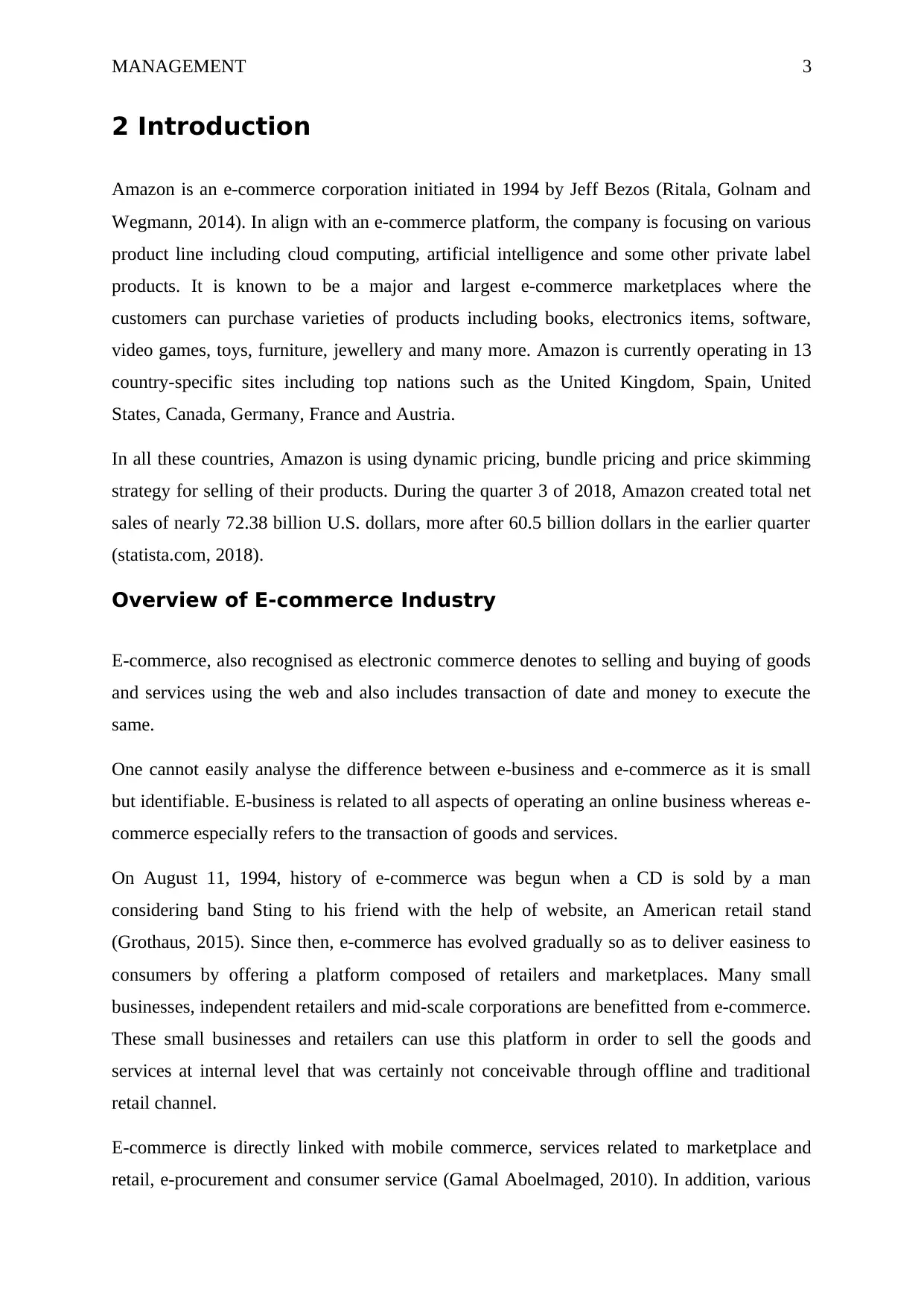
MANAGEMENT 3
2 Introduction
Amazon is an e-commerce corporation initiated in 1994 by Jeff Bezos (Ritala, Golnam and
Wegmann, 2014). In align with an e-commerce platform, the company is focusing on various
product line including cloud computing, artificial intelligence and some other private label
products. It is known to be a major and largest e-commerce marketplaces where the
customers can purchase varieties of products including books, electronics items, software,
video games, toys, furniture, jewellery and many more. Amazon is currently operating in 13
country-specific sites including top nations such as the United Kingdom, Spain, United
States, Canada, Germany, France and Austria.
In all these countries, Amazon is using dynamic pricing, bundle pricing and price skimming
strategy for selling of their products. During the quarter 3 of 2018, Amazon created total net
sales of nearly 72.38 billion U.S. dollars, more after 60.5 billion dollars in the earlier quarter
(statista.com, 2018).
Overview of E-commerce Industry
E-commerce, also recognised as electronic commerce denotes to selling and buying of goods
and services using the web and also includes transaction of date and money to execute the
same.
One cannot easily analyse the difference between e-business and e-commerce as it is small
but identifiable. E-business is related to all aspects of operating an online business whereas e-
commerce especially refers to the transaction of goods and services.
On August 11, 1994, history of e-commerce was begun when a CD is sold by a man
considering band Sting to his friend with the help of website, an American retail stand
(Grothaus, 2015). Since then, e-commerce has evolved gradually so as to deliver easiness to
consumers by offering a platform composed of retailers and marketplaces. Many small
businesses, independent retailers and mid-scale corporations are benefitted from e-commerce.
These small businesses and retailers can use this platform in order to sell the goods and
services at internal level that was certainly not conceivable through offline and traditional
retail channel.
E-commerce is directly linked with mobile commerce, services related to marketplace and
retail, e-procurement and consumer service (Gamal Aboelmaged, 2010). In addition, various
2 Introduction
Amazon is an e-commerce corporation initiated in 1994 by Jeff Bezos (Ritala, Golnam and
Wegmann, 2014). In align with an e-commerce platform, the company is focusing on various
product line including cloud computing, artificial intelligence and some other private label
products. It is known to be a major and largest e-commerce marketplaces where the
customers can purchase varieties of products including books, electronics items, software,
video games, toys, furniture, jewellery and many more. Amazon is currently operating in 13
country-specific sites including top nations such as the United Kingdom, Spain, United
States, Canada, Germany, France and Austria.
In all these countries, Amazon is using dynamic pricing, bundle pricing and price skimming
strategy for selling of their products. During the quarter 3 of 2018, Amazon created total net
sales of nearly 72.38 billion U.S. dollars, more after 60.5 billion dollars in the earlier quarter
(statista.com, 2018).
Overview of E-commerce Industry
E-commerce, also recognised as electronic commerce denotes to selling and buying of goods
and services using the web and also includes transaction of date and money to execute the
same.
One cannot easily analyse the difference between e-business and e-commerce as it is small
but identifiable. E-business is related to all aspects of operating an online business whereas e-
commerce especially refers to the transaction of goods and services.
On August 11, 1994, history of e-commerce was begun when a CD is sold by a man
considering band Sting to his friend with the help of website, an American retail stand
(Grothaus, 2015). Since then, e-commerce has evolved gradually so as to deliver easiness to
consumers by offering a platform composed of retailers and marketplaces. Many small
businesses, independent retailers and mid-scale corporations are benefitted from e-commerce.
These small businesses and retailers can use this platform in order to sell the goods and
services at internal level that was certainly not conceivable through offline and traditional
retail channel.
E-commerce is directly linked with mobile commerce, services related to marketplace and
retail, e-procurement and consumer service (Gamal Aboelmaged, 2010). In addition, various
Paraphrase This Document
Need a fresh take? Get an instant paraphrase of this document with our AI Paraphraser
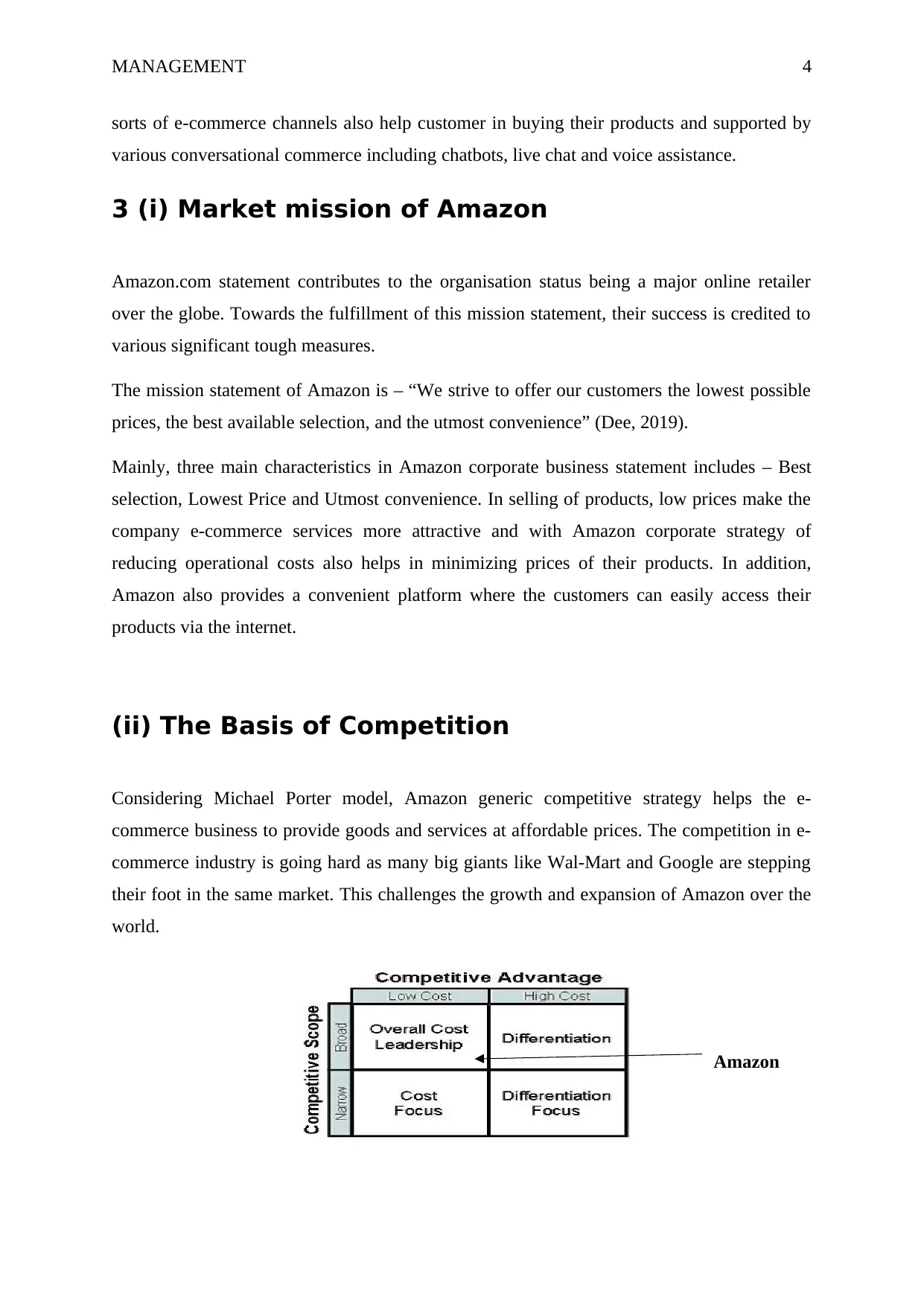
MANAGEMENT 4
sorts of e-commerce channels also help customer in buying their products and supported by
various conversational commerce including chatbots, live chat and voice assistance.
3 (i) Market mission of Amazon
Amazon.com statement contributes to the organisation status being a major online retailer
over the globe. Towards the fulfillment of this mission statement, their success is credited to
various significant tough measures.
The mission statement of Amazon is – “We strive to offer our customers the lowest possible
prices, the best available selection, and the utmost convenience” (Dee, 2019).
Mainly, three main characteristics in Amazon corporate business statement includes – Best
selection, Lowest Price and Utmost convenience. In selling of products, low prices make the
company e-commerce services more attractive and with Amazon corporate strategy of
reducing operational costs also helps in minimizing prices of their products. In addition,
Amazon also provides a convenient platform where the customers can easily access their
products via the internet.
(ii) The Basis of Competition
Considering Michael Porter model, Amazon generic competitive strategy helps the e-
commerce business to provide goods and services at affordable prices. The competition in e-
commerce industry is going hard as many big giants like Wal-Mart and Google are stepping
their foot in the same market. This challenges the growth and expansion of Amazon over the
world.
Amazon
sorts of e-commerce channels also help customer in buying their products and supported by
various conversational commerce including chatbots, live chat and voice assistance.
3 (i) Market mission of Amazon
Amazon.com statement contributes to the organisation status being a major online retailer
over the globe. Towards the fulfillment of this mission statement, their success is credited to
various significant tough measures.
The mission statement of Amazon is – “We strive to offer our customers the lowest possible
prices, the best available selection, and the utmost convenience” (Dee, 2019).
Mainly, three main characteristics in Amazon corporate business statement includes – Best
selection, Lowest Price and Utmost convenience. In selling of products, low prices make the
company e-commerce services more attractive and with Amazon corporate strategy of
reducing operational costs also helps in minimizing prices of their products. In addition,
Amazon also provides a convenient platform where the customers can easily access their
products via the internet.
(ii) The Basis of Competition
Considering Michael Porter model, Amazon generic competitive strategy helps the e-
commerce business to provide goods and services at affordable prices. The competition in e-
commerce industry is going hard as many big giants like Wal-Mart and Google are stepping
their foot in the same market. This challenges the growth and expansion of Amazon over the
world.
Amazon
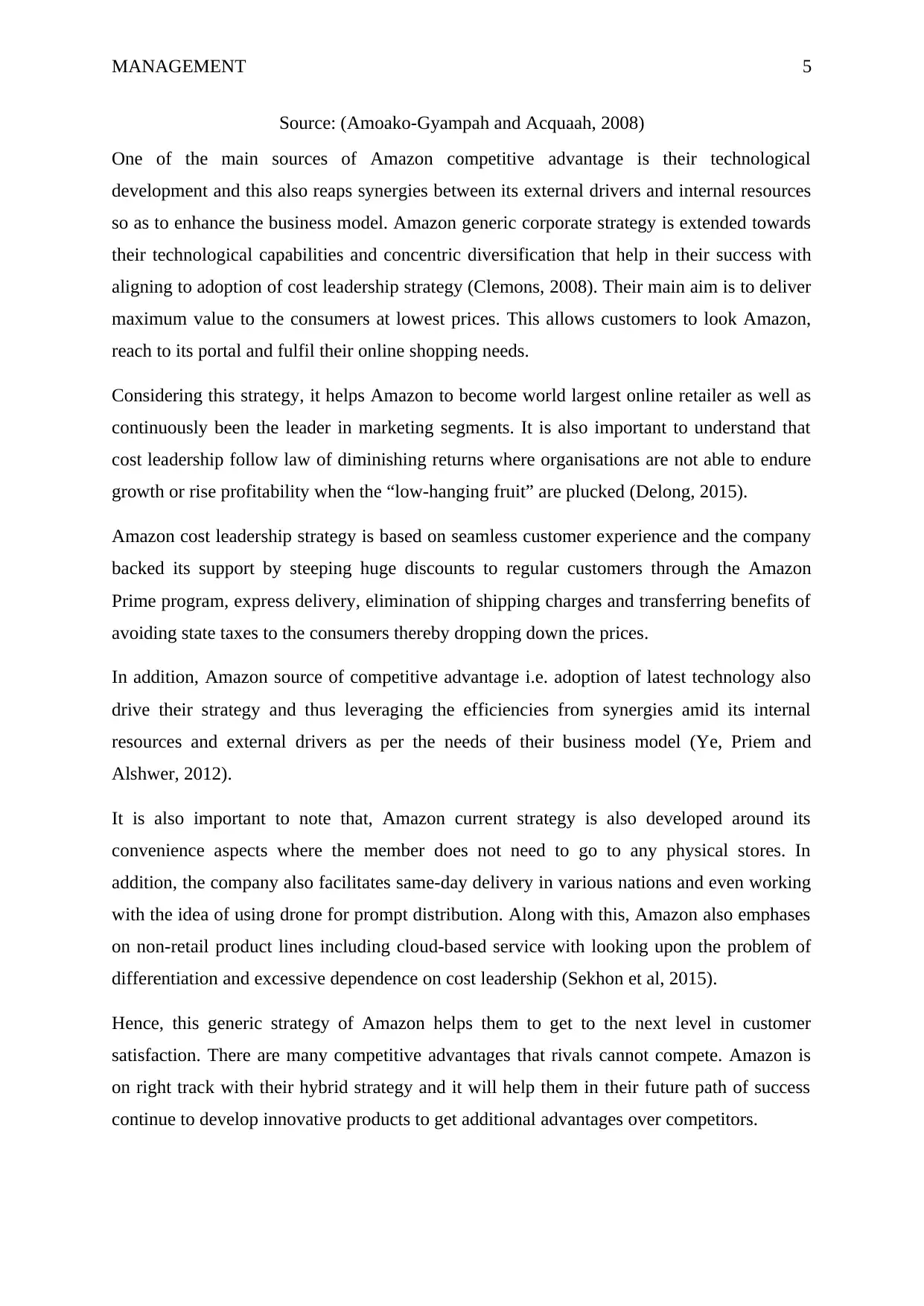
MANAGEMENT 5
Source: (Amoako-Gyampah and Acquaah, 2008)
One of the main sources of Amazon competitive advantage is their technological
development and this also reaps synergies between its external drivers and internal resources
so as to enhance the business model. Amazon generic corporate strategy is extended towards
their technological capabilities and concentric diversification that help in their success with
aligning to adoption of cost leadership strategy (Clemons, 2008). Their main aim is to deliver
maximum value to the consumers at lowest prices. This allows customers to look Amazon,
reach to its portal and fulfil their online shopping needs.
Considering this strategy, it helps Amazon to become world largest online retailer as well as
continuously been the leader in marketing segments. It is also important to understand that
cost leadership follow law of diminishing returns where organisations are not able to endure
growth or rise profitability when the “low-hanging fruit” are plucked (Delong, 2015).
Amazon cost leadership strategy is based on seamless customer experience and the company
backed its support by steeping huge discounts to regular customers through the Amazon
Prime program, express delivery, elimination of shipping charges and transferring benefits of
avoiding state taxes to the consumers thereby dropping down the prices.
In addition, Amazon source of competitive advantage i.e. adoption of latest technology also
drive their strategy and thus leveraging the efficiencies from synergies amid its internal
resources and external drivers as per the needs of their business model (Ye, Priem and
Alshwer, 2012).
It is also important to note that, Amazon current strategy is also developed around its
convenience aspects where the member does not need to go to any physical stores. In
addition, the company also facilitates same-day delivery in various nations and even working
with the idea of using drone for prompt distribution. Along with this, Amazon also emphases
on non-retail product lines including cloud-based service with looking upon the problem of
differentiation and excessive dependence on cost leadership (Sekhon et al, 2015).
Hence, this generic strategy of Amazon helps them to get to the next level in customer
satisfaction. There are many competitive advantages that rivals cannot compete. Amazon is
on right track with their hybrid strategy and it will help them in their future path of success
continue to develop innovative products to get additional advantages over competitors.
Source: (Amoako-Gyampah and Acquaah, 2008)
One of the main sources of Amazon competitive advantage is their technological
development and this also reaps synergies between its external drivers and internal resources
so as to enhance the business model. Amazon generic corporate strategy is extended towards
their technological capabilities and concentric diversification that help in their success with
aligning to adoption of cost leadership strategy (Clemons, 2008). Their main aim is to deliver
maximum value to the consumers at lowest prices. This allows customers to look Amazon,
reach to its portal and fulfil their online shopping needs.
Considering this strategy, it helps Amazon to become world largest online retailer as well as
continuously been the leader in marketing segments. It is also important to understand that
cost leadership follow law of diminishing returns where organisations are not able to endure
growth or rise profitability when the “low-hanging fruit” are plucked (Delong, 2015).
Amazon cost leadership strategy is based on seamless customer experience and the company
backed its support by steeping huge discounts to regular customers through the Amazon
Prime program, express delivery, elimination of shipping charges and transferring benefits of
avoiding state taxes to the consumers thereby dropping down the prices.
In addition, Amazon source of competitive advantage i.e. adoption of latest technology also
drive their strategy and thus leveraging the efficiencies from synergies amid its internal
resources and external drivers as per the needs of their business model (Ye, Priem and
Alshwer, 2012).
It is also important to note that, Amazon current strategy is also developed around its
convenience aspects where the member does not need to go to any physical stores. In
addition, the company also facilitates same-day delivery in various nations and even working
with the idea of using drone for prompt distribution. Along with this, Amazon also emphases
on non-retail product lines including cloud-based service with looking upon the problem of
differentiation and excessive dependence on cost leadership (Sekhon et al, 2015).
Hence, this generic strategy of Amazon helps them to get to the next level in customer
satisfaction. There are many competitive advantages that rivals cannot compete. Amazon is
on right track with their hybrid strategy and it will help them in their future path of success
continue to develop innovative products to get additional advantages over competitors.
⊘ This is a preview!⊘
Do you want full access?
Subscribe today to unlock all pages.

Trusted by 1+ million students worldwide

MANAGEMENT 6
(iii) Strategic Group Analysis
Doz and Kosonen (2010) defined strategic group as clusters of firms that possibly respond
correspondingly to changes in environment. As per the perception of Porter, there will be
only one strategic group if all firms in the industry opt for same strategy. On the other hand,
every organisation could be an altered strategic group.
The strategic group of Amazon is analysed with the help of Porter Five Forces model that is
built on the concept of key objectives for any enterprise should be to attain competitive
advantage over its rivals.
Amazon Industry Forces and Attractiveness
Michael Porter strategic analysis tool can benefit the management to analyse competitive
position in the industry (Bose, 2008). The five forces model could be also useful for
comprehensive analysis of market that may affect the future business performance.
Competitive Rivalry
There is a huge list of competitors in case of Amazon as competition is high in case of online
retailers. In these recent years, many business and companies come on an online platform to
sell their products and services to the consumers (Amit and Zott, 2012). Alibaba, Wal-Mart
and Flipkart are the three most competitors giving tough competition to Amazon. They are all
considered to be direct competitors of Amazon, however, there are some indirect competitors
too who affect Amazon in their decision making and plans. Therefore, Amazon is required to
invest more in market research in order to be the leader in e-commerce market.
Bargaining Power of Suppliers
In case of Amazon, Bargaining Power of Suppliers is low. As a giant brand in e-commerce
industry, Amazon has the power to control their supply chain suppliers and all the suppliers
are required to work with set rules and regulations as their major proportion of the revenue
highly depend on Amazon. Amazon consists of 2 million sellers worldwide which represent
40% of net sales on Amazon (finance.yahoo, 2018). It can also be said that suppliers
switching cost for the company is also small.
(iii) Strategic Group Analysis
Doz and Kosonen (2010) defined strategic group as clusters of firms that possibly respond
correspondingly to changes in environment. As per the perception of Porter, there will be
only one strategic group if all firms in the industry opt for same strategy. On the other hand,
every organisation could be an altered strategic group.
The strategic group of Amazon is analysed with the help of Porter Five Forces model that is
built on the concept of key objectives for any enterprise should be to attain competitive
advantage over its rivals.
Amazon Industry Forces and Attractiveness
Michael Porter strategic analysis tool can benefit the management to analyse competitive
position in the industry (Bose, 2008). The five forces model could be also useful for
comprehensive analysis of market that may affect the future business performance.
Competitive Rivalry
There is a huge list of competitors in case of Amazon as competition is high in case of online
retailers. In these recent years, many business and companies come on an online platform to
sell their products and services to the consumers (Amit and Zott, 2012). Alibaba, Wal-Mart
and Flipkart are the three most competitors giving tough competition to Amazon. They are all
considered to be direct competitors of Amazon, however, there are some indirect competitors
too who affect Amazon in their decision making and plans. Therefore, Amazon is required to
invest more in market research in order to be the leader in e-commerce market.
Bargaining Power of Suppliers
In case of Amazon, Bargaining Power of Suppliers is low. As a giant brand in e-commerce
industry, Amazon has the power to control their supply chain suppliers and all the suppliers
are required to work with set rules and regulations as their major proportion of the revenue
highly depend on Amazon. Amazon consists of 2 million sellers worldwide which represent
40% of net sales on Amazon (finance.yahoo, 2018). It can also be said that suppliers
switching cost for the company is also small.
Paraphrase This Document
Need a fresh take? Get an instant paraphrase of this document with our AI Paraphraser
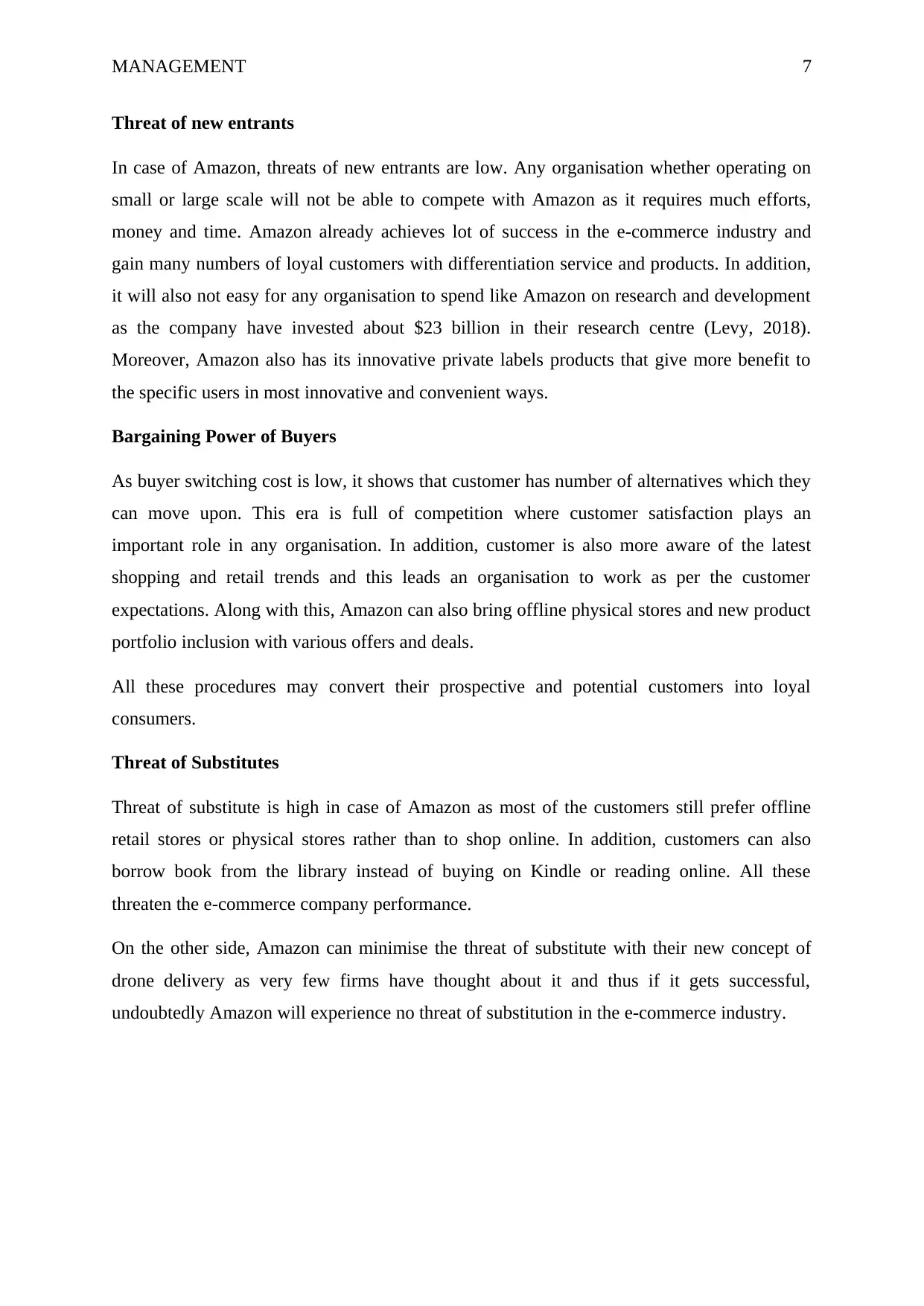
MANAGEMENT 7
Threat of new entrants
In case of Amazon, threats of new entrants are low. Any organisation whether operating on
small or large scale will not be able to compete with Amazon as it requires much efforts,
money and time. Amazon already achieves lot of success in the e-commerce industry and
gain many numbers of loyal customers with differentiation service and products. In addition,
it will also not easy for any organisation to spend like Amazon on research and development
as the company have invested about $23 billion in their research centre (Levy, 2018).
Moreover, Amazon also has its innovative private labels products that give more benefit to
the specific users in most innovative and convenient ways.
Bargaining Power of Buyers
As buyer switching cost is low, it shows that customer has number of alternatives which they
can move upon. This era is full of competition where customer satisfaction plays an
important role in any organisation. In addition, customer is also more aware of the latest
shopping and retail trends and this leads an organisation to work as per the customer
expectations. Along with this, Amazon can also bring offline physical stores and new product
portfolio inclusion with various offers and deals.
All these procedures may convert their prospective and potential customers into loyal
consumers.
Threat of Substitutes
Threat of substitute is high in case of Amazon as most of the customers still prefer offline
retail stores or physical stores rather than to shop online. In addition, customers can also
borrow book from the library instead of buying on Kindle or reading online. All these
threaten the e-commerce company performance.
On the other side, Amazon can minimise the threat of substitute with their new concept of
drone delivery as very few firms have thought about it and thus if it gets successful,
undoubtedly Amazon will experience no threat of substitution in the e-commerce industry.
Threat of new entrants
In case of Amazon, threats of new entrants are low. Any organisation whether operating on
small or large scale will not be able to compete with Amazon as it requires much efforts,
money and time. Amazon already achieves lot of success in the e-commerce industry and
gain many numbers of loyal customers with differentiation service and products. In addition,
it will also not easy for any organisation to spend like Amazon on research and development
as the company have invested about $23 billion in their research centre (Levy, 2018).
Moreover, Amazon also has its innovative private labels products that give more benefit to
the specific users in most innovative and convenient ways.
Bargaining Power of Buyers
As buyer switching cost is low, it shows that customer has number of alternatives which they
can move upon. This era is full of competition where customer satisfaction plays an
important role in any organisation. In addition, customer is also more aware of the latest
shopping and retail trends and this leads an organisation to work as per the customer
expectations. Along with this, Amazon can also bring offline physical stores and new product
portfolio inclusion with various offers and deals.
All these procedures may convert their prospective and potential customers into loyal
consumers.
Threat of Substitutes
Threat of substitute is high in case of Amazon as most of the customers still prefer offline
retail stores or physical stores rather than to shop online. In addition, customers can also
borrow book from the library instead of buying on Kindle or reading online. All these
threaten the e-commerce company performance.
On the other side, Amazon can minimise the threat of substitute with their new concept of
drone delivery as very few firms have thought about it and thus if it gets successful,
undoubtedly Amazon will experience no threat of substitution in the e-commerce industry.

MANAGEMENT 8
(iv) The activities and resources of the company
Resource-based view
Resource-Based View contends that an organisation possess resources allow them to gain
competitive advantage and some aspects of those leads to greater long-run performance.
Various resources that are rare and valuable may lead to competitive advantage in the
industry (Ndofor, Sirmon and He, 2011).
Amazon mature technology, brand image, expert personnel, and customer awareness are the
most significant aspect treasured for Amazon. In addition, Amazon amazing customer
relationship management, well-organized network of distributors and suppliers and huge
diversity of products depict their advantage over traditional retailers.
Some of the company resources are difficult to imitate as it requires capital and economies of
scale (Galbreath and Galvin, 2008). In addition, imitating the user recognition system is not
easy as many new organisations would not having previous purchase records of customers.
Resources are divided into both tangible and intangible assets where tangible resources
include employees and offices, distributions centres and storage houses. In case of Amazon,
these tangible resources only support Amazon in-terms of functioning but they are not a
source of distinct core competency for Amazon. On the other hand, Amazon intangible
resources include its goodwill and brand reputation that help Amazon in globalising and
managed to gain important market share and access.
Resources Competencies
Threshold capabilities Tangible:
1) Management Team
2) Suppliers
3) Fulfilment centres
4) Web infrastructure
Intangible:
1) Skills of
discovering and
implementing web
infrastructure.
1) Recruiting and
strengthening staff.
2) The usage of web
infrastructure.
3) The administration
of fulfilment
centres.
(iv) The activities and resources of the company
Resource-based view
Resource-Based View contends that an organisation possess resources allow them to gain
competitive advantage and some aspects of those leads to greater long-run performance.
Various resources that are rare and valuable may lead to competitive advantage in the
industry (Ndofor, Sirmon and He, 2011).
Amazon mature technology, brand image, expert personnel, and customer awareness are the
most significant aspect treasured for Amazon. In addition, Amazon amazing customer
relationship management, well-organized network of distributors and suppliers and huge
diversity of products depict their advantage over traditional retailers.
Some of the company resources are difficult to imitate as it requires capital and economies of
scale (Galbreath and Galvin, 2008). In addition, imitating the user recognition system is not
easy as many new organisations would not having previous purchase records of customers.
Resources are divided into both tangible and intangible assets where tangible resources
include employees and offices, distributions centres and storage houses. In case of Amazon,
these tangible resources only support Amazon in-terms of functioning but they are not a
source of distinct core competency for Amazon. On the other hand, Amazon intangible
resources include its goodwill and brand reputation that help Amazon in globalising and
managed to gain important market share and access.
Resources Competencies
Threshold capabilities Tangible:
1) Management Team
2) Suppliers
3) Fulfilment centres
4) Web infrastructure
Intangible:
1) Skills of
discovering and
implementing web
infrastructure.
1) Recruiting and
strengthening staff.
2) The usage of web
infrastructure.
3) The administration
of fulfilment
centres.
⊘ This is a preview!⊘
Do you want full access?
Subscribe today to unlock all pages.

Trusted by 1+ million students worldwide

MANAGEMENT 9
Capabilities for competitive
advantage
Tangible:
1) IT software talent
2) Enhancing IT
services.
Intangible:
1) Building
technology and
innovation
2) Brand recognition.
3) Skills of managing
supply chain.
4) Capability to
sustain a strong
position of cash
flow.
1) Management of
supply chain.
2) Respond to
customer feedback
and requirements.
3) Financial
Management
4) Technology and
innovation
development.
Considering value proposition of Amazon, Jeff Bezos continuously point out three value
proposition. They are illustrated in the diagram below,
These three elements are termed as significant proportions bring into line well with what
individuals say are the explanations they buying on Amazon.
Value Chain Analysis
In highly competitive business environment, companies are delivering superior quality
products to attain long-term competitiveness (Singh, Garg and Deshmukh, 2008). In order to
Lower Prices Vast Selection User convenience
Capabilities for competitive
advantage
Tangible:
1) IT software talent
2) Enhancing IT
services.
Intangible:
1) Building
technology and
innovation
2) Brand recognition.
3) Skills of managing
supply chain.
4) Capability to
sustain a strong
position of cash
flow.
1) Management of
supply chain.
2) Respond to
customer feedback
and requirements.
3) Financial
Management
4) Technology and
innovation
development.
Considering value proposition of Amazon, Jeff Bezos continuously point out three value
proposition. They are illustrated in the diagram below,
These three elements are termed as significant proportions bring into line well with what
individuals say are the explanations they buying on Amazon.
Value Chain Analysis
In highly competitive business environment, companies are delivering superior quality
products to attain long-term competitiveness (Singh, Garg and Deshmukh, 2008). In order to
Lower Prices Vast Selection User convenience
Paraphrase This Document
Need a fresh take? Get an instant paraphrase of this document with our AI Paraphraser
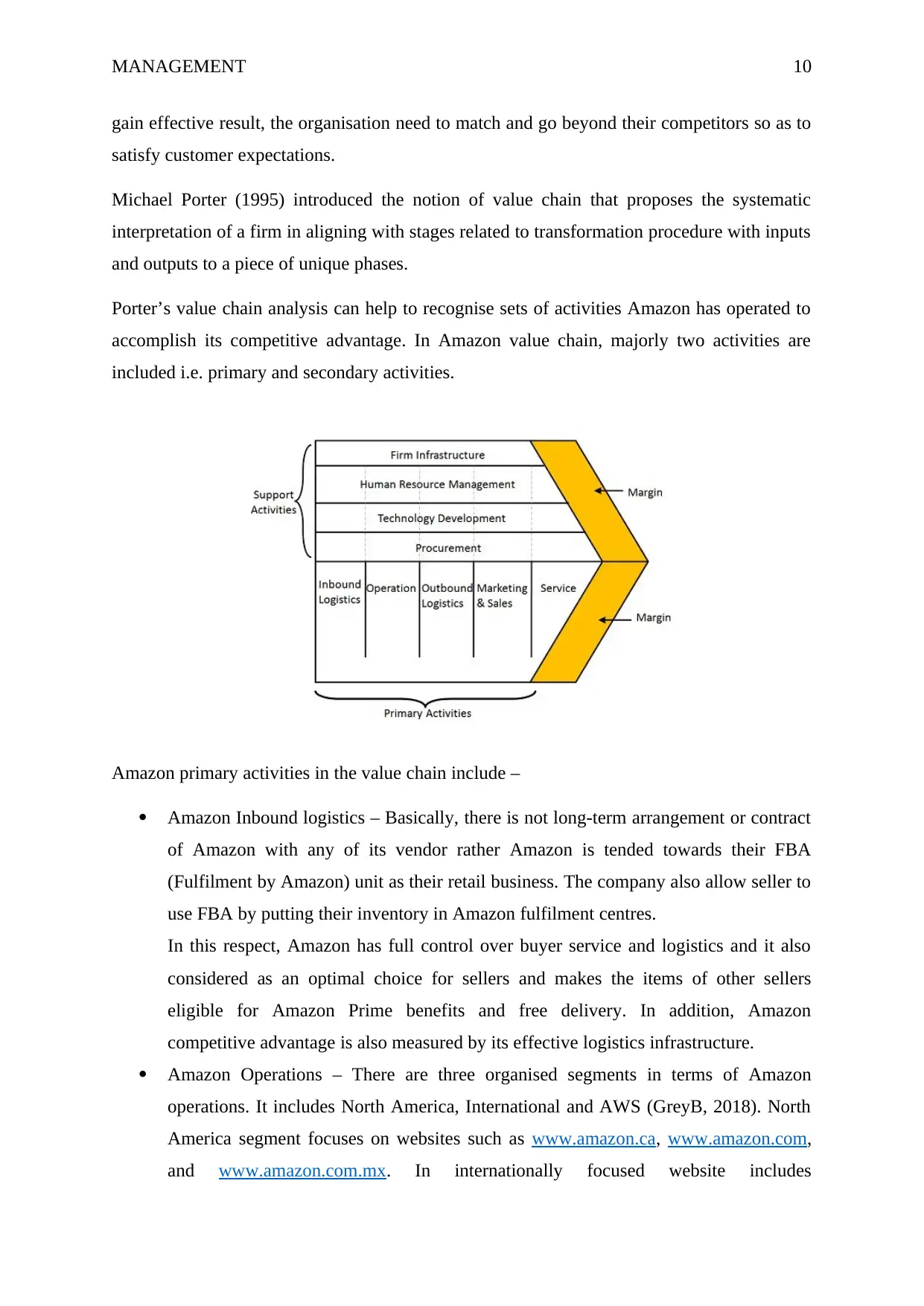
MANAGEMENT 10
gain effective result, the organisation need to match and go beyond their competitors so as to
satisfy customer expectations.
Michael Porter (1995) introduced the notion of value chain that proposes the systematic
interpretation of a firm in aligning with stages related to transformation procedure with inputs
and outputs to a piece of unique phases.
Porter’s value chain analysis can help to recognise sets of activities Amazon has operated to
accomplish its competitive advantage. In Amazon value chain, majorly two activities are
included i.e. primary and secondary activities.
Amazon primary activities in the value chain include –
Amazon Inbound logistics – Basically, there is not long-term arrangement or contract
of Amazon with any of its vendor rather Amazon is tended towards their FBA
(Fulfilment by Amazon) unit as their retail business. The company also allow seller to
use FBA by putting their inventory in Amazon fulfilment centres.
In this respect, Amazon has full control over buyer service and logistics and it also
considered as an optimal choice for sellers and makes the items of other sellers
eligible for Amazon Prime benefits and free delivery. In addition, Amazon
competitive advantage is also measured by its effective logistics infrastructure.
Amazon Operations – There are three organised segments in terms of Amazon
operations. It includes North America, International and AWS (GreyB, 2018). North
America segment focuses on websites such as www.amazon.ca, www.amazon.com,
and www.amazon.com.mx. In internationally focused website includes
gain effective result, the organisation need to match and go beyond their competitors so as to
satisfy customer expectations.
Michael Porter (1995) introduced the notion of value chain that proposes the systematic
interpretation of a firm in aligning with stages related to transformation procedure with inputs
and outputs to a piece of unique phases.
Porter’s value chain analysis can help to recognise sets of activities Amazon has operated to
accomplish its competitive advantage. In Amazon value chain, majorly two activities are
included i.e. primary and secondary activities.
Amazon primary activities in the value chain include –
Amazon Inbound logistics – Basically, there is not long-term arrangement or contract
of Amazon with any of its vendor rather Amazon is tended towards their FBA
(Fulfilment by Amazon) unit as their retail business. The company also allow seller to
use FBA by putting their inventory in Amazon fulfilment centres.
In this respect, Amazon has full control over buyer service and logistics and it also
considered as an optimal choice for sellers and makes the items of other sellers
eligible for Amazon Prime benefits and free delivery. In addition, Amazon
competitive advantage is also measured by its effective logistics infrastructure.
Amazon Operations – There are three organised segments in terms of Amazon
operations. It includes North America, International and AWS (GreyB, 2018). North
America segment focuses on websites such as www.amazon.ca, www.amazon.com,
and www.amazon.com.mx. In internationally focused website includes

MANAGEMENT 11
www.amazon.com.br, www.amazon.com.au, www.amazon.cn and others. The last
segment deals with Amazon Web Services (AWS) relating to international selling of
database, storage, computing and other offerings of services. All these services are
intended towards other enterprises, start-ups and business firms. AWS is used by
many big organisations including Netflix, NASA, Samsung, Nokia and so on.
Usually, AWS deals with more than 516 features and services (Snapp, 2018).
Moreover, there are also more than one million consumers signifying organisations
and businesses of different sizes.
Amazon Outbound logistics – Beforetime, Amazon has to depend upon the delivery
services of FedEx and TNT for overnight delivery, though, they recently make plan to
lease 20 Boeing Freighters in addition to Amazon an air cargo network. This help the
company to gain independence from the third parties in operating its logistics. In
addition, Amazon also announced that they will use drones for faster delivery
purpose. Other aspects of Amazon outbound logistics includes –
1. Physical stores: Amazon operates on around 629 physical retail locations,
comprising its Whole Foods grocery stores, bookstores, Amazon Go
convenience stores and travelling Treasure Trucks (Redman, 2018).
2. Fulfilment centres – E-commerce giant Amazon operates on more than 75
fulfilment centres backed by robotic technology for managing and shipping of
products,
3. Digital Delivery – It includes products and services that can be effectively
downloaded from Amazon website.
Amazon marketing and Sales – Amazon is continuously increasing its marketing
expenses from past several years. It includes various promotional costs and Amazon
amounted to over 13 billion U.S. dollars, up from ten billion U.S. dollars in the
preceding year (statista.com, 2018). Moreover, their market budget was more in 2016
as compared to Wal-Mart, Home Depot, Target and Kroger combined. Hence, it can
be said that value is created with excessive marketing investment in the value chain of
Amazon.
In addition, Amazon marketing message also conveys that they have largest selection
of products to choose from with attractive offers, deals, event and experiences. All
these are used in a cohesive way so as to communicate the promotional message in an
effective way.
www.amazon.com.br, www.amazon.com.au, www.amazon.cn and others. The last
segment deals with Amazon Web Services (AWS) relating to international selling of
database, storage, computing and other offerings of services. All these services are
intended towards other enterprises, start-ups and business firms. AWS is used by
many big organisations including Netflix, NASA, Samsung, Nokia and so on.
Usually, AWS deals with more than 516 features and services (Snapp, 2018).
Moreover, there are also more than one million consumers signifying organisations
and businesses of different sizes.
Amazon Outbound logistics – Beforetime, Amazon has to depend upon the delivery
services of FedEx and TNT for overnight delivery, though, they recently make plan to
lease 20 Boeing Freighters in addition to Amazon an air cargo network. This help the
company to gain independence from the third parties in operating its logistics. In
addition, Amazon also announced that they will use drones for faster delivery
purpose. Other aspects of Amazon outbound logistics includes –
1. Physical stores: Amazon operates on around 629 physical retail locations,
comprising its Whole Foods grocery stores, bookstores, Amazon Go
convenience stores and travelling Treasure Trucks (Redman, 2018).
2. Fulfilment centres – E-commerce giant Amazon operates on more than 75
fulfilment centres backed by robotic technology for managing and shipping of
products,
3. Digital Delivery – It includes products and services that can be effectively
downloaded from Amazon website.
Amazon marketing and Sales – Amazon is continuously increasing its marketing
expenses from past several years. It includes various promotional costs and Amazon
amounted to over 13 billion U.S. dollars, up from ten billion U.S. dollars in the
preceding year (statista.com, 2018). Moreover, their market budget was more in 2016
as compared to Wal-Mart, Home Depot, Target and Kroger combined. Hence, it can
be said that value is created with excessive marketing investment in the value chain of
Amazon.
In addition, Amazon marketing message also conveys that they have largest selection
of products to choose from with attractive offers, deals, event and experiences. All
these are used in a cohesive way so as to communicate the promotional message in an
effective way.
⊘ This is a preview!⊘
Do you want full access?
Subscribe today to unlock all pages.

Trusted by 1+ million students worldwide
1 out of 20
Related Documents
Your All-in-One AI-Powered Toolkit for Academic Success.
+13062052269
info@desklib.com
Available 24*7 on WhatsApp / Email
![[object Object]](/_next/static/media/star-bottom.7253800d.svg)
Unlock your academic potential
Copyright © 2020–2025 A2Z Services. All Rights Reserved. Developed and managed by ZUCOL.




